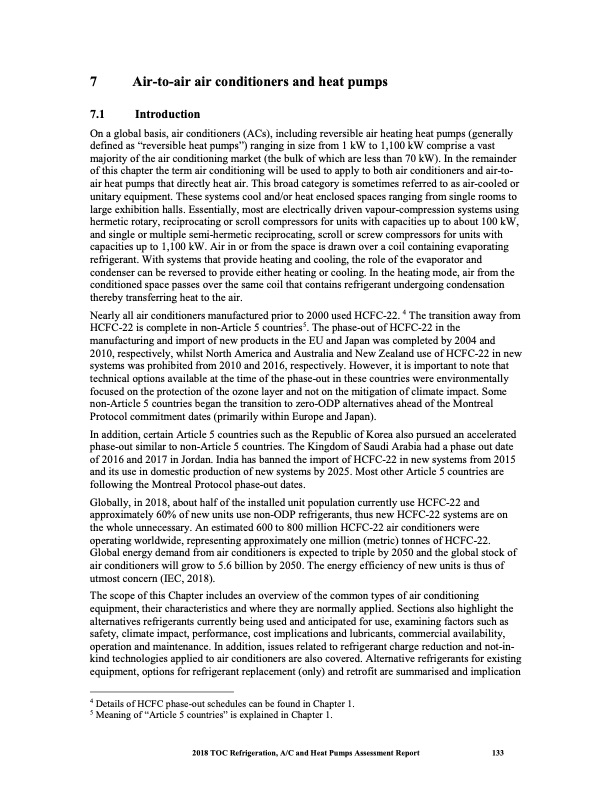
PDF Publication Title:
Text from PDF Page: 146
7 Air-to-air air conditioners and heat pumps 7.1 Introduction On a global basis, air conditioners (ACs), including reversible air heating heat pumps (generally defined as “reversible heat pumps”) ranging in size from 1 kW to 1,100 kW comprise a vast majority of the air conditioning market (the bulk of which are less than 70 kW). In the remainder of this chapter the term air conditioning will be used to apply to both air conditioners and air-to- air heat pumps that directly heat air. This broad category is sometimes referred to as air-cooled or unitary equipment. These systems cool and/or heat enclosed spaces ranging from single rooms to large exhibition halls. Essentially, most are electrically driven vapour-compression systems using hermetic rotary, reciprocating or scroll compressors for units with capacities up to about 100 kW, and single or multiple semi-hermetic reciprocating, scroll or screw compressors for units with capacities up to 1,100 kW. Air in or from the space is drawn over a coil containing evaporating refrigerant. With systems that provide heating and cooling, the role of the evaporator and condenser can be reversed to provide either heating or cooling. In the heating mode, air from the conditioned space passes over the same coil that contains refrigerant undergoing condensation thereby transferring heat to the air. Nearly all air conditioners manufactured prior to 2000 used HCFC-22. 4 The transition away from HCFC-22 is complete in non-Article 5 countries5. The phase-out of HCFC-22 in the manufacturing and import of new products in the EU and Japan was completed by 2004 and 2010, respectively, whilst North America and Australia and New Zealand use of HCFC-22 in new systems was prohibited from 2010 and 2016, respectively. However, it is important to note that technical options available at the time of the phase-out in these countries were environmentally focused on the protection of the ozone layer and not on the mitigation of climate impact. Some non-Article 5 countries began the transition to zero-ODP alternatives ahead of the Montreal Protocol commitment dates (primarily within Europe and Japan). In addition, certain Article 5 countries such as the Republic of Korea also pursued an accelerated phase-out similar to non-Article 5 countries. The Kingdom of Saudi Arabia had a phase out date of 2016 and 2017 in Jordan. India has banned the import of HCFC-22 in new systems from 2015 and its use in domestic production of new systems by 2025. Most other Article 5 countries are following the Montreal Protocol phase-out dates. Globally, in 2018, about half of the installed unit population currently use HCFC-22 and approximately 60% of new units use non-ODP refrigerants, thus new HCFC-22 systems are on the whole unnecessary. An estimated 600 to 800 million HCFC-22 air conditioners were operating worldwide, representing approximately one million (metric) tonnes of HCFC-22. Global energy demand from air conditioners is expected to triple by 2050 and the global stock of air conditioners will grow to 5.6 billion by 2050. The energy efficiency of new units is thus of utmost concern (IEC, 2018). The scope of this Chapter includes an overview of the common types of air conditioning equipment, their characteristics and where they are normally applied. Sections also highlight the alternatives refrigerants currently being used and anticipated for use, examining factors such as safety, climate impact, performance, cost implications and lubricants, commercial availability, operation and maintenance. In addition, issues related to refrigerant charge reduction and not-in- kind technologies applied to air conditioners are also covered. Alternative refrigerants for existing equipment, options for refrigerant replacement (only) and retrofit are summarised and implication 4 Details of HCFC phase-out schedules can be found in Chapter 1. 5 Meaning of “Article 5 countries” is explained in Chapter 1. 2018 TOC Refrigeration, A/C and Heat Pumps Assessment Report 133PDF Image | Heat Pumps Technical Options

PDF Search Title:
Heat Pumps Technical OptionsOriginal File Name Searched:
RTOC-assessment-report-2018_0.pdfDIY PDF Search: Google It | Yahoo | Bing
CO2 Organic Rankine Cycle Experimenter Platform The supercritical CO2 phase change system is both a heat pump and organic rankine cycle which can be used for those purposes and as a supercritical extractor for advanced subcritical and supercritical extraction technology. Uses include producing nanoparticles, precious metal CO2 extraction, lithium battery recycling, and other applications... More Info
Heat Pumps CO2 ORC Heat Pump System Platform More Info
| CONTACT TEL: 608-238-6001 Email: greg@infinityturbine.com | RSS | AMP |